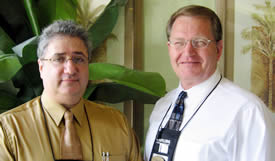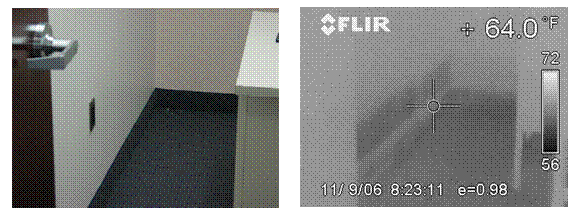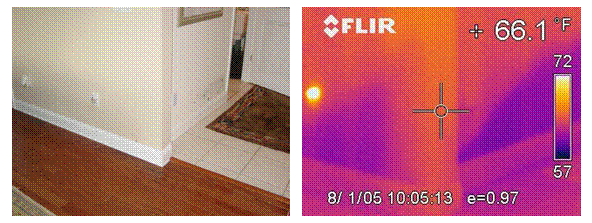Article Archive
Using Infrared Thermography to Aid in Indoor Air Quality Inspection & Mold Remediation
 Lance Eisen, Chief of Operations
Lance Eisen, Chief of Operations
Douglas Hoffman, Executive Director
NORMI, Inc.
Abita Springs, LA 70420
Ph: 877-251-2296
Abstract
Mold Inspectors and Remediators are now using infrared thermography to help diagnose and attack hidden microbial problems in buildings. Being armed with as much information as can be gathered allows inspectors to complete indoor air quality inspection and mold remediation with the highest degree of success possible. This paper will discuss the techniques used to incorporate infrared data and air quality test results with data from other invasive testing methods.
Introduction
One of the greatest challenges facing Indoor Air Quality Specialists, Inspectors, and Remediators is the lack of industry regulations. Very few States require licensing or certifications to enable an individual or company to provide Mold Testing and Remediation services. At this time, only Texas and Louisiana require licensing or special training to perform these services as a business.
Over the last few years, media hype, escalating insurance claims, and health sensitivity due to environmental conditions have prompted a rapid growth in companies providing indoor air quality services. A rapidly changing industry provides opportunities for new products, training, and techniques to flood the market. Unfortunately, without standardized regulations, many products and procedures provide more of a “gimmick effect” than usable results
The National Organization of Remediators and Mold Inspectors (NORMI) is working with other organizations and governmental agencies to establish practical protocols and techniques to stabilize this rapidly growing industry.
Most indoor air quality (IAQ) and surface sampling techniques used today are valid and useful as tools in the process of diagnosing IAQ problems. However, the results of these methods often only show symptoms of poor indoor air quality. Trained technicians have to interpret visible clues and lab results to identify and locate the cause(s) of poor indoor air quality. Industry leading training organizations, such as NORMI, are incorporating the use of infrared thermography into their Certified Mold Inspector, Remediator, and Assessor classes.
Discussion
In 2006, NORMI and Infraspection Institute have teamed up in a collaborative effort to provide on-site and distant training opportunities for professionals in a variety of industries. This infusion of training and resources from both of these entities helps bridge the gap that has existed between IAQ Professionals and Infrared Thermographers. Building Sciences and Indoor Air Quality are no longer exclusive arenas for industry professionals. By providing training and the latest information and techniques to industry professionals, NORMI and Infraspection Institute are creating a stable, professional, and credible service provider base for a multitude of industries. Infrared trained IAQ specialists and IAQ trained thermographers can now provide a hybrid service for their customers that is cost effective, expedient, and effective.
Thermal Imaging and Indoor Air Quality
Infrared thermography has been around for many years. With recent changes in the technology, manufacturing, and the price of infrared equipment, IAQ specialists are now incorporating its use as an investigative tool for finding hidden sources of indoor air quality problems.
For the purpose of this document, indoor air quality problems refers to the presence of microbial growth in the form of mold, bacteria, and/or yeast. In most cases, several elements are required for indoor air quality contaminants to flourish like a food source, spores, and moisture. Most existing testing methods sample small areas and require processing to determine the presence of microbial problems. Thermal imaging identifies in real time suspicious areas and conditions that can be the source of microbial growth.
Example 1

The image on the left is of an office in a 20,000 square foot building that had a large sewage leak within the previous 24 hours. Maintenance crews responded, cleaned surfaces, and extracted the water from the carpet. Fans were then used to dry exposed surfaces. A visual inspection of the room didn’t identify a potential for contamination and growth.
The infrared image on the right indicates a thermal exception that appears to extend upward from the floor. A non-invasive moisture meter was used to confirm the presence of moisture in the wallboard. The readings of moisture saturation matched the exceptions visible in the image on the right.
In this example, the infrared camera was used as an investigative and predictive tool. The trained IAQ specialist can use this type of information to develop sanitization and remediation protocols.
Example 2

The image on the left shows visible microbial growth on the surface of the wallboard in a home. The growth was cultured and identified at a laboratory. The homeowner’s insurance company authorized remediation of the growth only on the surface of the wall.
The image on the right was taken during a secondary inspection using infrared thermography. The second report indicated thermal changes in the wallboard consistent with moisture intrusion. In short, when presented with the second report, the insurance company approved and paid for the proper required remediation.
Conclusion
The science and technology of the indoor air quality business is developing into a high-tech investigative industry. As the cost of investigative tools decreases, the ability of IAQ Inspectors and Remediators to use advanced technologies becomes more commonplace. The impact of this change is more accurate remediation protocols, less demolition, and a monetary savings for the customer.
As a NORMI Certified Mold Inspector and a Certified Level I Thermographer, I often get calls to assist other mold inspectors and remediators. Being able to provide detailed visible evidence or indications of moisture intrusion in real time is an invaluable resource.
Mold, mildew, bacteria, and other microbial contaminants have been around for millions of years. In the short term, they are not going away. The 21st century now offers many scientific advances in technologies that can help the IAQ professional provide cost effective and proven solutions for business and home owners. Infrared thermal imaging is one of the powerful tools now available to the IAQ Professional.
Advertisement


